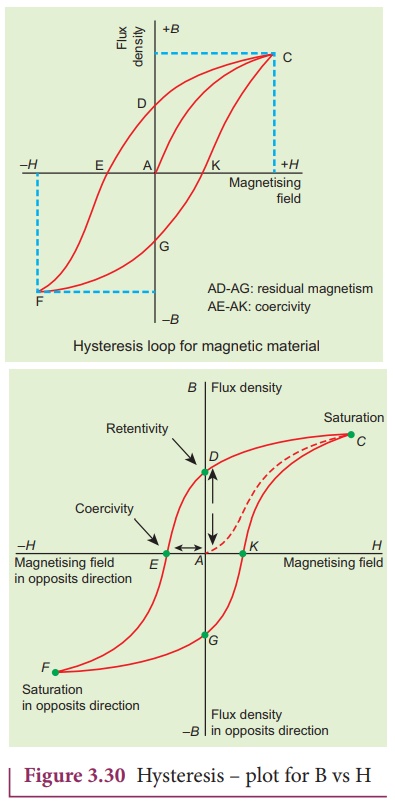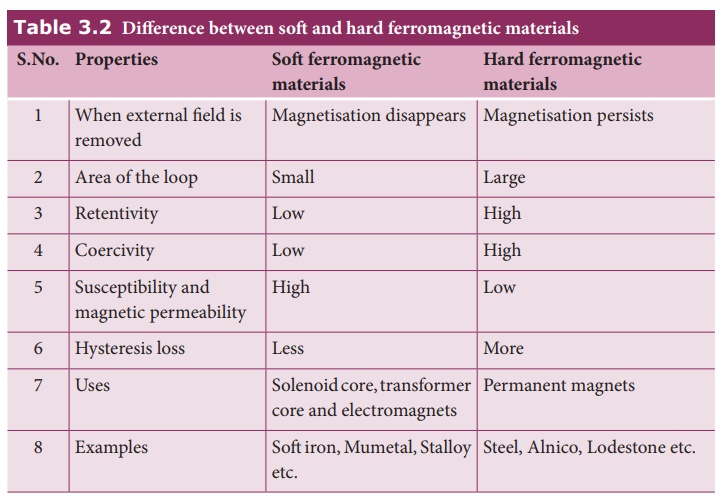Chapter: 12th Physics : Magnetism and Magnetic Effects of Electric Current
Hysteresis
HYSTERESIS
When a ferromagnetic
material is kept in a magnetising field, the material gets magnetised by
induction. An important characteristic of ferromagnetic material is that the
variation of magnetic induction ![]() with magnetising field
with magnetising field ![]() is not linear. It means that the ratio B/H = ┬Ą is not a constant.
is not linear. It means that the ratio B/H = ┬Ą is not a constant.
Let us study this
behaviour in detail.
A ferromagnetic material
(example, Iron) is magnetised slowly by a magnetising field ![]() The magnetic induction
The magnetic induction ![]() of
the material increases from point A with the magnitude of the magnetising field
and then attains a saturated level. This response of the material is depicted
by the path AC as shown in Figure 3.30. Saturation magnetization is defined as
the maximum point up to which the material can be magnetised by applying the
magnetising field.
of
the material increases from point A with the magnitude of the magnetising field
and then attains a saturated level. This response of the material is depicted
by the path AC as shown in Figure 3.30. Saturation magnetization is defined as
the maximum point up to which the material can be magnetised by applying the
magnetising field.
If the magnetising field
is now reduced, the magnetic induction also decreases but does not retrace the
original path CA. It takes different path CD. When the magnetising field is
zero, the magnetic induction is not zero and it has positive value. This
implies that some

The residual magnetism AD present in the
specimen is called remanence or retentivity. It is defined as the ability of
the materials to retain the magnetism in them even magnetising field vanishes.
In order to demagnetise
the material, the magnetising field is gradually increased in the reverse
direction. Now the magnetic induction decreases along DE and becomes zero at E.
The magnetising field AE in the reverse direction is required to bring residual
magnetism to zero. The magnitude of the reverse magnetising
field for which the residual magnetism of the material vanishes is called its
coercivity.
Further increase of ![]() in the reverse direction, the magnetic induction increases along EF until it
reaches saturation at F in the reverse direction. If magnetising field is
decreased and then increased with direction reversed, the magnetic induction
traces the path FGKC. This closed curve ACDEFGKC is called hysteresis loop and
it represents a cycle of magnetisation.
in the reverse direction, the magnetic induction increases along EF until it
reaches saturation at F in the reverse direction. If magnetising field is
decreased and then increased with direction reversed, the magnetic induction
traces the path FGKC. This closed curve ACDEFGKC is called hysteresis loop and
it represents a cycle of magnetisation.
In the entire cycle, the
magnetic induction B lags behind the magnetising field H. This phenomenon of
lagging of magnetic induction behind the magnetising field is called
hysteresis. Hysteresis means ŌĆślagging behindŌĆÖ.
Hysteresis loss
During the magnetisation
of the specimen through a cycle, there is loss of energy in the form of heat.
This loss is attributed to the rotation and orientation of molecular magnets in
various directions. It is found that the energy lost (or dissipated) per unit
volume of the material when it is carried through one cycle of magnetisation is
equal to the area of the hysteresis loop. Thus, the loss of energy for a
complete cycle is ŌłåE,

where ![]() is in ampere ŌĆō metre2 and
is in ampere ŌĆō metre2 and ![]() is in ampere per meter. The loss in
energy is measured in joules.
is in ampere per meter. The loss in
energy is measured in joules.
Hard and soft magnetic materials
Based on the shape and
size of the hysteresis loop, ferromagnetic materials are classified as soft
magnetic materials with smaller area and hard magnetic materials with larger
area. The comparison of the hysteresis loops for two magnetic materials is
shown in Figure 3.31. Properties of soft and hard magnetic materials are
compared in Table 3.2.


Applications of hysteresis loop
The significance of
hysteresis loop is that it provides information such as retentivity,
coercivity, permeability, susceptibility and energy loss during one cycle of
magnetisation for each ferromagnetic material. Therefore, the study of
hysteresis loop will help us in selecting proper and suitable material for a
given purpose. Some examples:
i) Permanent magnets:
The materials with high
retentivity, high coercivity and high permeability are suitable for making
permanent magnets. Examples: Steel and Alnico
ii) Electromagnets:
The materials with high initial permeability, low retentivity, low coercivity and thin hysteresis loop with smaller area are preferred to make electromagnets.
Examples: Soft iron and
Mumetal (Nickel Iron alloy).
iii) Core of the transformer:
The materials with high
initial permeability, large magnetic induction and thin hysteresis loop with
smaller area are needed to design transformer cores.
Examples: Soft iron
EXAMPLE 3.13
The following figure
shows the variation of intensity of magnetisation with the applied magnetic
field intensity for three magnetic materials X, Y and Z. Identify the materials
X,Y and Z.

Solution
The slope of M-H graph
measures the magnetic susceptibility, which is
Žćm = M / H
Material X: Slope is
positive and larger value. So, it is a ferromagnetic material.
Material Y: Slope is
positive and lesser value than X. So, it could be a paramagnetic material.
Material Z: Slope is negative and hence, it is a diamagnetic material.
Related Topics